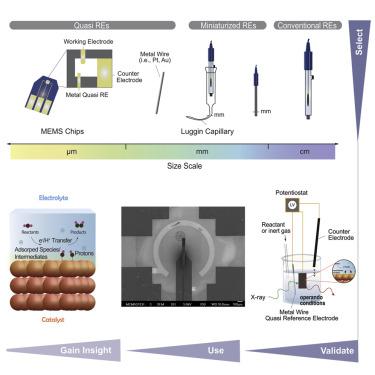Chem Catalysis Pub Date : 2021-07-22 , DOI: 10.1016/j.checat.2021.07.001 Wajdi Alnoush 1 , Robert Black 2 , Drew Higgins 1

|
The development and implementation of in situ and operando characterization techniques to understand electrocatalytic processes, establish structure-property-performance relationships, and elucidate properties of electrified interfaces aid in accelerating the discovery and design of new materials for sustainable energy technologies. The validity of operando characterization techniques is predicated on the ability to accurately and reliably control the electrochemical potential of the working electrode—factors dictated by the reference electrode. Because the utilization of an appropriate reference electrode is a prerequisite for reliable operando experiments, guidelines for the judicious selection, validation, and use of reference electrodes are necessary. In this review, we discuss existing knowledge and highlight examples of the use of reference electrodes (including quasi-reference electrodes), provide practical tips, and highlight challenges in the context of operando experiments in aqueous electrolytes. We discuss critical concepts (calibration, potential drift, and preparation) and prospective opportunities regarding the use of reference electrodes for operando characterization of electrocatalytic processes.
中文翻译:

原位和原位电催化研究中参比电极的明智选择、验证和使用
原位和原位表征技术的开发和实施,以了解电催化过程、建立结构-性能-性能关系并阐明带电界面的特性,有助于加速可持续能源技术新材料的发现和设计。操作表征技术的有效性取决于准确可靠地控制工作电极电化学电位的能力——这些因素由参比电极决定。因为使用合适的参比电极是可靠操作的先决条件实验、参考电极的明智选择、验证和使用指南是必要的。在这篇综述中,我们讨论了现有知识并重点介绍了使用参考电极(包括准参考电极)的示例,提供了实用技巧,并强调了在水性电解质操作实验背景下的挑战。我们讨论了关于使用参考电极对电催化过程进行操作表征的关键概念(校准、电位漂移和制备)和预期机会。

























 京公网安备 11010802027423号
京公网安备 11010802027423号